Chandrashekhar Rai
Low-Complexity Super-Resolution Signature Estimation of XL-MIMO FMCW Radar
Jun 09, 2025Abstract:Extremely Large-Scale (XL) multiple input multiple output (MIMO) antenna systems combined with ultra-wide signal bandwidth (BW) offer the potential for ultra-high-resolution sensing in frequency modulated continuous wave (FMCW) radars. However, the use of ultra-wide BW results in significant spatial delays across the array aperture, comparable to the range resolution, leading to the spatial wideband effect (SWE). SWE introduces coupling between the range and angle domains, rendering conventional narrowband signal processing techniques ineffective for target signature estimation. In this paper, we propose an efficient super-resolution signature estimation technique for XL-MIMO FMCW radars operating under SWE, leveraging compressive sensing (CS) methods. The proposed 2D CS-based approach offers low computational complexity, making it highly suitable for real-time applications in large-scale radar systems. Numerical simulation results validate the superior performance of the proposed method compared to existing wideband and narrowband estimation techniques.
An Artificial Intelligence Enabled Signature Estimation of Dual Wideband Systems in Ultra-Low Signal-to-Noise Ratio
Apr 19, 2025Abstract:Millimeter-wave (mmWave) massive Multiple Input Multiple Output (MIMO) systems encounter both spatial wideband spreading and temporal wideband effects in the communication channels of individual users. Accurate estimation of a user's channel signature -- specifically, the direction of arrival and time of arrival -- is crucial for designing efficient beamforming transceivers, especially under noisy observations. In this work, we propose an Artificial Intelligence (AI)-enabled framework for estimating the channel signature of a user's location in mmWave massive MIMO systems. Our approach explicitly accounts for spatial wideband spreading, finite basis leakage effects, and significant unknown receiver noise. We demonstrate the effectiveness of a denoising convolutional neural network with residual learning for recovering channel responses, even when channel gains are of extremely low amplitude and embedded in ultra-high receiver noise environments. Notably, our method successfully recovers spatio-temporal diversity branches at signal-to-noise ratios as low as -20 dB. Furthermore, we introduce a local gravitation-based clustering algorithm to infer the number of physical propagation paths (unknown a priori) and to identify their respective support in the delay-angle domain of the denoised response. To complement our approach, we design tailored metrics for evaluating denoising and clustering performance within the context of wireless communications. We validate our framework through system-level simulations using Orthogonal Frequency Division Multiplexing (OFDM) with a Quadrature Phase Shift Keying (QPSK) modulation scheme over mmWave fading channels, highlighting the necessity and robustness of the proposed methods in ultra-low SNR scenarios.
Multi-target Range, Doppler and Angle estimation in MIMO-FMCW Radar with Limited Measurements
Feb 03, 2025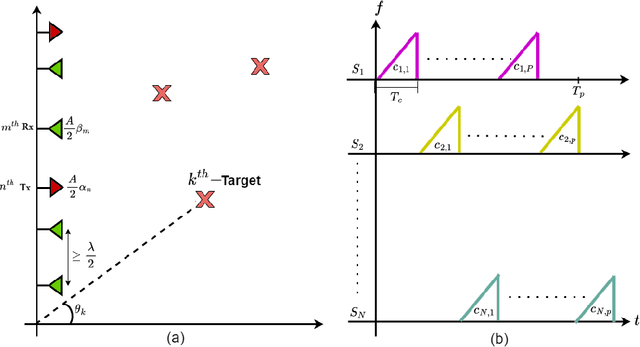


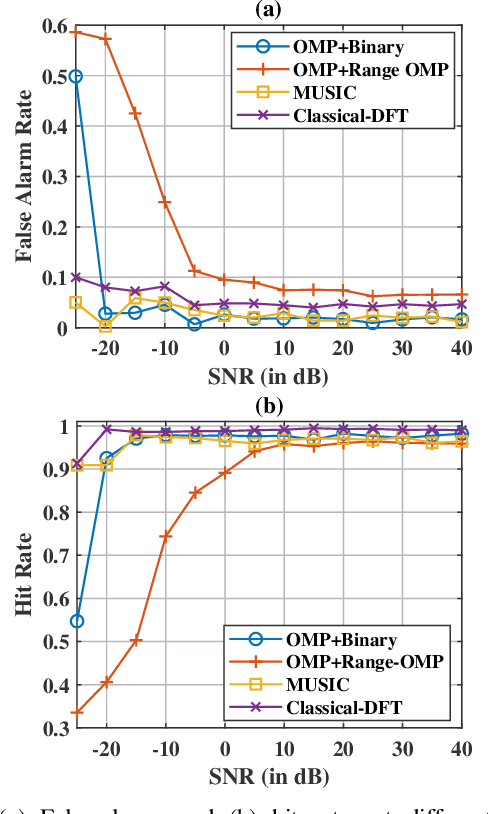
Abstract:Multiple-input multiple-output (MIMO) radar offers several performance and flexibility advantages over traditional radar arrays. However, high angular and Doppler resolutions necessitate a large number of antenna elements and the transmission of numerous chirps, leading to increased hardware and computational complexity. While compressive sensing (CS) has recently been applied to pulsed-waveform radars with sparse measurements, its application to frequency-modulated continuous wave (FMCW) radar for target detection remains largely unexplored. In this paper, we propose a novel CS-based multi-target localization algorithm in the range, Doppler, and angular domains for MIMO-FMCW radar, where we jointly estimate targets' velocities and angles of arrival. To this end, we present a signal model for sparse-random and uniform linear arrays based on three-dimensional spectral estimation. For range estimation, we propose a discrete Fourier transform (DFT)-based focusing and orthogonal matching pursuit (OMP)-based techniques, each with distinct advantages, while two-dimensional CS is used for joint Doppler-angle estimation. Leveraging the properties of structured random matrices, we establish theoretical uniform and non-uniform recovery guarantees with high probability for the proposed framework. Our numerical experiments demonstrate that our methods achieve similar detection performance and higher resolution compared to conventional DFT and MUSIC with fewer transmitted chirps and antenna elements.
Low Complexity DoA-ToA Signature Estimation for Multi-Antenna Multi-Carrier Systems
Sep 13, 2024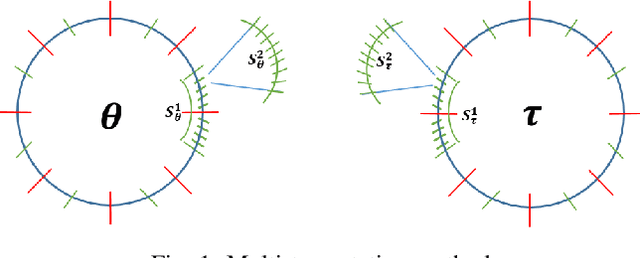
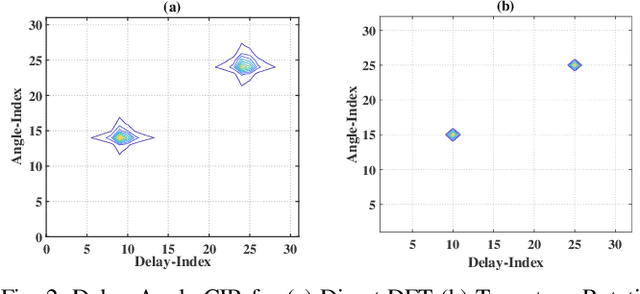

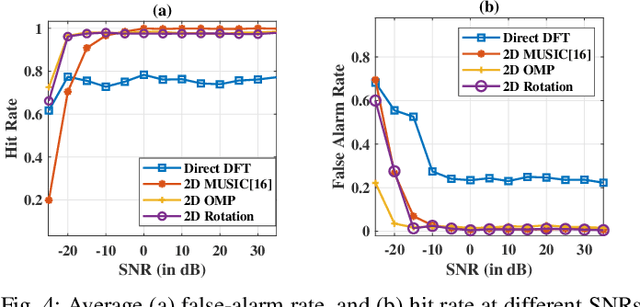
Abstract:Accurate direction of arrival (DoA) and time of arrival (ToA) estimation is an stringent requirement for several wireless systems like sonar, radar, communications, and dual-function radar communication (DFRC). Due to the use of high carrier frequency and bandwidth, most of these systems are designed with multiple antennae and subcarriers. Although the resolution is high in the large array regime, the DoA-ToA estimation accuracy of the practical on-grid estimation methods still suffers from estimation inaccuracy due to the spectral leakage effect. In this article, we propose DoA-ToA estimation methods for multi-antenna multi-carrier systems with an orthogonal frequency division multiplexing (OFDM) signal. In the first method, we apply discrete Fourier transform (DFT) based coarse signature estimation and propose a low complexity multistage fine-tuning for extreme enhancement in the estimation accuracy. The second method is based on compressed sensing, where we achieve the super-resolution by taking a 2D-overcomplete angle-delay dictionary than the actual number of antenna and subcarrier basis. Unlike the vectorized 1D-OMP method, we apply the low complexity 2D-OMP method on the matrix data model that makes the use of CS methods practical in the context of large array regimes. Through numerical simulations, we show that our proposed methods achieve the similar performance as that of the subspace-based 2D-MUSIC method with a significant reduction in computational complexity.
 Add to Chrome
Add to Chrome Add to Firefox
Add to Firefox Add to Edge
Add to Edge